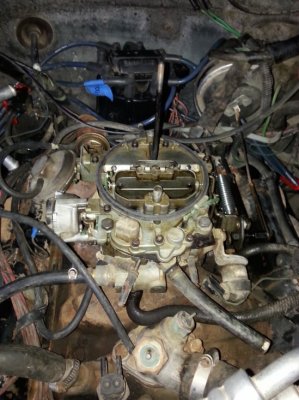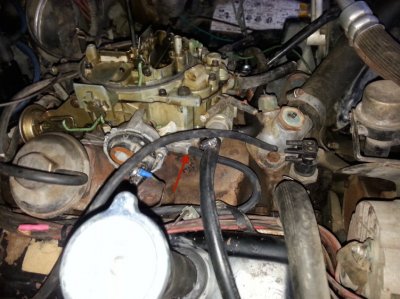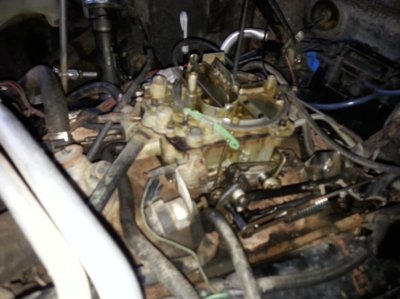Figure out what years what is?
You know, if you're up for it - and the junkyards in your area have plenty of these trucks - you could probably pull all the components required to restore most of the emissions package.
By far, the most expensive components are the one's associated with the air injection system - and that's if you can even find them. So, since that part of the emissions package is not a factor, restoring the remainder would not be all that hard.
There is a really good chance that your ECU is still fully operational - those early engine control systems were fairly basic and the modules were simple. Other than a tendency to develop cracks in the solder joints of the PC board, they were dependable.
It can seem confusing but, keep in mind that the engine control and emissions packages are independent of each other and are operated by different means:
The engine control system is primarily electrical. It is a group of:
1. Sensors, actuators and electronics on the engine.
2. The ECU under the dash.
3. The wiring that links everything together.
On the other hand, the emissions control system is almost totally vacuum operated. The only electrically controlled components in the emissions system - that I can think of - are the air pump diverter valve solenoids and a vapor canister purge solenoid. The operation of everything else is by vacuum and these components are controlled by either the various TVS's or the ported connections on the carburetor.
Here is a picture showing the location of the most common engine components that were used on the 1986 C/K series:
You must be registered for see images attach
Your engine code is going to be an "L" . This can be confirmed by checking the 8th digit of your VIN.
There are two types of "L" engine codes Federal & California. Assuming you have a Federal package, the following devices were originally installed:
Engine V8-350
Application 4 Bbl. Exc. Calif.
Engine Code [1] L
Figure No. 119
Devices & Systems
AIR, BPEGR, CC, DEC-V, DV, DVDV, EEC, EFE, EFE/DS-TVS, EGR-BS, EGR-SOL, ESC, ESC-KS, OC, PCV, TAC, TCC
The component key:
EXPLANATION OF SYSTEMS AND DEVICES
ABA Air Bleed Actuator
ACC Auxiliary Charcoal Canister
ACS Air Control Valve
AIR Air Injection Reaction
AIR-DS Air Injection Reaction Divert Solenoid
AIR-MGMT Air Injection Reaction Management System
AIR-SVV Air Injection Reaction Switching Solenoid Valve
APS Absolute Pressure Sensor
ASV Absolute Pressure Sensor
A.T. Automatic Transmission
BARO Barometric Pressure Sensor
BPEGR Back Pressure Exhaust Gas Recirculation
BPS Barometric Pressure Sensor
BPT Back Pressure Transducer
BVV Bowl Vent Valve
CAC Cold Advance Control
CC Charcoal Canister
CCV Canister Control Vent
CDR Crankcase Depression Regulator
CLFC Closed Loop Fuel Control
CP-TVS Canister Purge Thermal Vacuum Switch
CP-SOL Canister Purge Solenoid
CTS Coolant Temperature Sensor
C3 Computer Command Control
CV Crankcase Ventilation
DC Deceleration Control
DEC Diesel Electronic Control System
DEC-MCV Deceleration Mixture Control Valve
DEC-V Deceleration Valve
DPS Differential Pressure Sensor
DC/CP-TVS Distributor Spark & Canister Purge ThermalVacuum Switch
DS-DV Distributor Spark Delay Valve
DS/EGR-TVS Distributor Spark & Exhaust Gas Recirculation Thermal Vacuum Switch
DS/P-TVS Distributor Purge Thermal Vacuum Switch
DS/TCC-TVS Distributor Spark & Tramsmission ConverterClutch Thermal VacuumSwitch
DS-TVS Distributor Purge Thermal Vacuum Switch
DS-VCV Distributor Spark Vacuum Check Valve
DS-VR Distributor Spark Vacuum Regulator
DTVS Distributor Thermal Vacuum Switch
DV Diverter Valve
DVDV Distributor Vacuum Delay Valve
DVR-SOL Diverter Solenoid
EAC Electric Air Control Solenoid
EAC-V Electric Air Control Valve
EAC/EAS-V Electric Air Control & Electric Air Switching(Integral Type)
ED/ES-V Electric Diverter/Electric Air Switching Valve
EDV Electric Diverter Valve
EEC Evaporative Emission Control
EEC-PV Evaporative Emission Control Purge Valve
EEC-S Evaporative Emission Control Sensor
EEC-TVS Evaporative Emission Control Thermal Vacuum Switch
EFE Early Fuel Evaporation System
EFE/DS-TVS Early Fuel Evaporation & Diustributor Spark ThermalVacuum Switch
EFE-SOL Early Fuel Evaporation Solenoid
EFE/EGR-SOL Early Fuel Evaporation/Exhaust Gas Recirculation Solenoid
EFE-TVS Early Fuel Evaporation Thermal Vacuum Switch
EFE-VCV Early F uel Evaporation Vacuum Check Valve
EGR Exhaust Gas Recirculation
EGR-BPT Exhaust Gas Recirculation Back Pressure Transducer
EGR-BS Exhaust Gas Recircualtion Bleed Solenoid
EGR/CP-TVS Exhaust Gas Recircualtion & Canister Purge Thermal vacuum Switch
EGR/CP/DS-TVS Exhaust Gas Recirculation, Canister Purge &Distributor Spark Thermal Vacuum Switch
EGR/CP/TS-TVS Exhaust Gas Recirculation, Canister Purge &Trapped Spark Thermal Vacuum Switch
EGR/CP/TCC-TVS Exhaust Gas Recircualtion, Canister Purge &Torque Converter Clutch Thermal Switch
EGR/PWM-SOL Pulse Width Modulated Exhaust Gas Recirculation
EGR-S Exhaust Gas Recirculation Sensor
EGR-SOL Exhaust Gas Recirculation Solenoid
EGR-TDS Exhaust Gas Recirculaiton Temperature Diagnosis Switch
EGR-TVS Exhaust Recircualtion Thermal Vacuum Switch
EGR/TCC-TVS Exhaust Gas Recircualtion & Torque Converter ClutchThermal Vacuum Switch
EGR-VBS Exhaust Gas Circulation Vacuum Bleed Solenoid
EGR-VDS Exhaust Gas Recirculation Vacuum Diagnosis Switch
EGR-VRV Exhaust Gas Recircualtion Vacuum Regulator Valve
EGR-VS Exhaust Gas Recircualtion Vacuum Switch
EGR-VSV Exhaust Gas Recircualtion Vacuum Switching Valve
EPR Exhaust Pressure Regulator
EPR-SOL-EPR Solenoid
EPR Electric Purge Solenoid
EPR-SOL-EPR Solenoid
EPS Electric Purge Solenoid
ESC Electronic Spark Control System
ESC-KS Electronic Spark Control Knock Sensor
ESR Engine Speed Relay
ESS Engine Speed Sensor
EST Electronic Spark Timing
ETK Electronic Throttle Kicker
ETM Elapsed Timer Module
EVRV Electronic Vacuum Regulator Valve
FCS Fuel Control System
FIS Fast Idle Solenoid
FM Fuel Module
FVV Fuel Vapor Valve
HDE Heavy Duty Emission Calibration
HIC Hot Idle Compensator
IAC Idle Air Control
ISC Idle Speed control Motor
ISS Idle Stop Solenoid
LALS Lean Authority Limit Switch
LDE Light Duty Emission Calibration
MAIR Managed Air Injection Reaction
MAP Manifold Absolute Pressure Sensor
MAT Manifold Air Temperature Sensor
MCS Mixture Control System
MDE Medium Duty Emission Calibration
MDPS Manifold Depression Pressure Sensor
M.T. Manual Transmission
OC Oxidizing Catalyst
ORC Oxidation Reduction (3-Way) Catalyst
ORC/OC Oxidation Reduction & Oxidizing (3-Way &dual bed) Catalyst
OS Oxygen Sensor
PCS Purge Control Solenoid
PCV Positive Crankcase Ventilation
PWM-EGR Pulse Width Modulated Exhaust Gas Recirculation
P-TVS Purge Thermal Vacuum Switch
RVR Response Vacuum Reducer
SCS Slow Idle Fuel Cut Solenoid
SRDV Spark Retard Delay Valve
SSCS Stepped Speed Control Solenoid
SVB-TVS Secondary Vacuum Break Thermal Vacuum Switch
SVB/EGR-TVS Secondary Vacuum Break Exhaust GasRecirculation Thermal Vacuum Switch
TAC Thermostatic Air Cleaner
TBI Throttle Body Injection
TCC Tranwmission Torque Converter
TCC/EGR/CP/TS-VS Torque Converter Clutch, EGR, Canister Purge& Trapped Spark Thermal Switch
TCC-TVS Transmission Converter Clutch Thermal Vacuum Switch
TCC-VDV Transmission Converter Clutch Vacuum Delay Valve
TIVS Tip-In Vacuum Switch
TK Throttle Kicker
TPS Throttle Position Sensor
TRC Throttle Return Control
TVR Throttle Valve Relay
TVS Thermal Vacuum Switch
TVSS Trapped Vacuum Spark System
TVV Thermal Vacuum Valve
VB-TVS Vacuum Break Thermal Vacuum Switch
VCV Vacuum Control Valve
VDV Vacuum Delay Valve
VMV Vacuum Modulator Valve
VR Vacuum Regulator
VRV Vacuum Regulator Valve
VS Vacuum Sensor
VSS Vehicle Speed Sensor
VSV Vacuum Switching Valve
If you go through the list of what was on your truck (and eliminate all the emissions stuff) you have only about 5 components.
I don't know why that ISC actuator is not listed - it isnot on the Calif list either.




